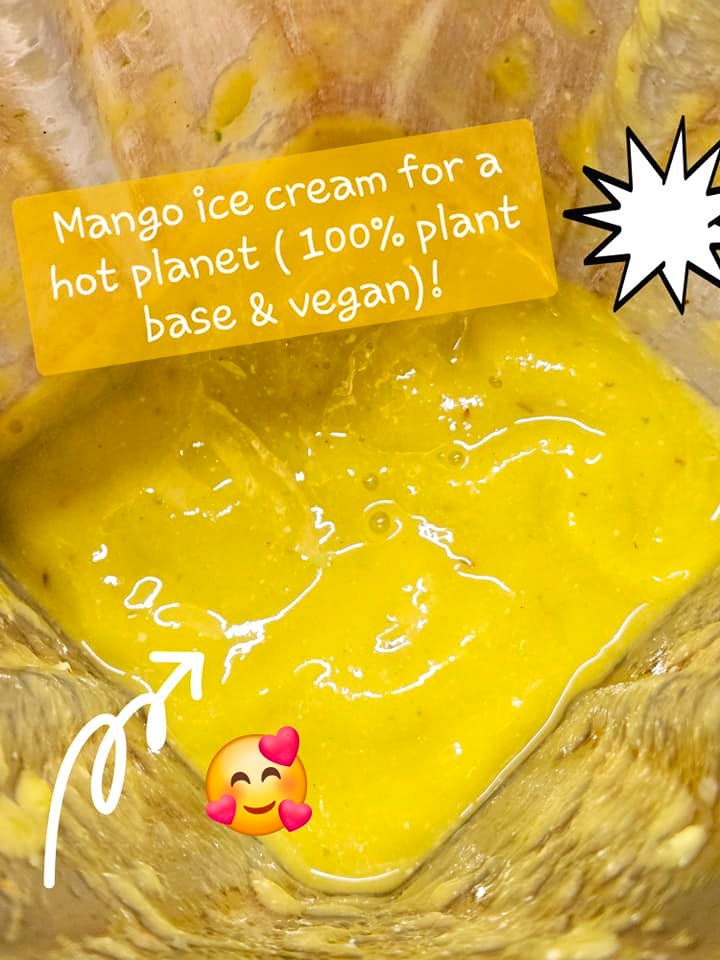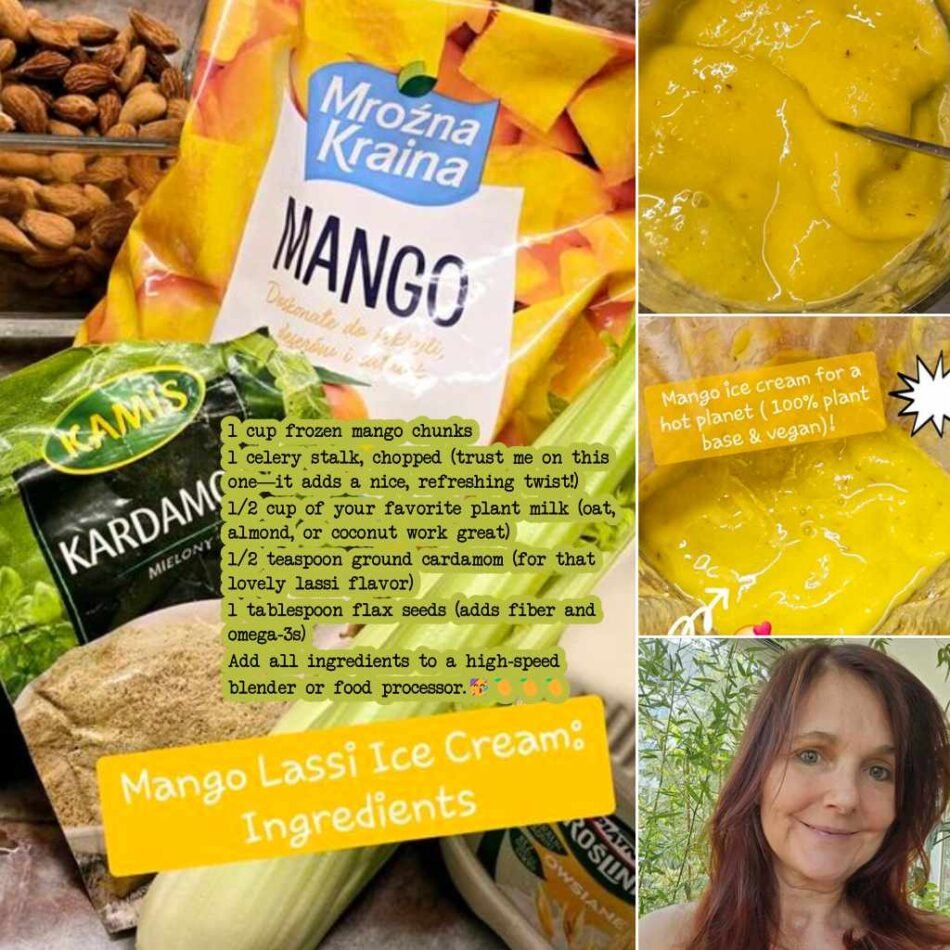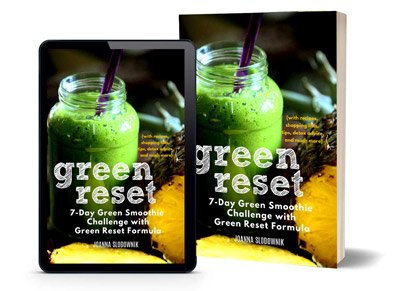Plant-Based Mango Ice Cream: Cool Down with Compassion 🌱
When the heat outside is relentless—and this happens more often now as our planet is heating up faster than ever, we look for ways to cool down. So, why not do it in a way that’s kind to the earth, animals, and ourselves?
Enter: this 100% plant-based, super quick and easy Mango Ice Cream recipe inspired by the classic flavors of a mango lassi!
Unlike traditional ice cream, which is packed with dairy and sugar, this plant-based version is super-healthy, refreshing, and incredibly satisfying (even though it may not be as creamy and sweet).
And the best part? It’s made with just a few simple ingredients in 5 minutes tops!
Ready to dive in? Let’s get blending!

Mango Ice Cream Recipe (Vegan & Delicious)
Ingredients:
- 1 cup frozen mango chunks
- 1 celery stalk, chopped (trust me on this one—it adds a nice, refreshing twist!)
- 1/2 cup of your favorite plant milk (oat, almond, or coconut work great)
- 1/2 teaspoon ground cardamom (for that lovely lassi flavor)
- 1 tablespoon flax seeds (adds fiber and omega-3s)
Instructions:
- Add all ingredients to a high-speed blender or food processor.
- Blend until smooth and creamy, pausing to scrape down the sides as needed.
- Serve immediately for a soft-serve texture or freeze for 1-2 hours if you prefer it firmer.

Calories and Nutrition:
This recipe is for one portion, but feel free to double or triple it, as this plant-based mango ice cream has around 150-170 calories per serving. Compare that with your average dairy-based ice cream, which can pack in 200-300 calories and loads of added sugars. It’s a refreshing alternative with wholesome ingredients, fiber, and natural sweetness.
Does it Taste Like “Real” Ice Cream?
Many people would say that not exactly—or not at all!—but that actually a GOOD thing. Traditional ice cream is made with dairy, sugar, and other stuff, ingredients that are often unhealthy, cruel, environmentally damaging, and nutritionally empty. Dairy, in particular, is unnecessary for humans, harms animals, and contributes significantly to greenhouse gas emissions. Seriously–we’re raising and killing billions of cow mothers and their babies—just to have a drink that is meant for infants for another species. It’s insane!
The Truth About Dairy:
The dairy industry is not just harmful to animals; it’s also terrible to our planet. It’s wasteful, water-intensive, and completely unnecessary. No human needs to drink the milk meant for calves—it’s time we let go of this outdated practice. Not your mom, not your milk!
So, what does “real” mean anyway? Real, to me, means kind, sustainable, and delicious. And this Mango (N)Ice Cream is all that—and so much more.

“Got Milk?” Not Always: How Colonialism Brought Cow’s Milk to India
Speaking of mango lassi—you’d think dairy was always a big deal in India, right? After all, India’s got a rich vegetarian tradition and sacred cows roaming the streets. But here’s the twist: cow’s milk wasn’t always so popular. In fact, it was the British who really pushed it during colonial times, reshaping diets and food culture in ways that still affect us today.
Before the British showed up, many Indians thrived on plant-based diets filled with legumes, grains, veggies, and fruits. Sure, some dairy like ghee and yogurt had their place, mostly in religious rituals and among wealthier folks, but everyday cow’s milk? Not as big as you’d think. The traditional plant-based approach was not just healthy but also aligned with Ayurvedic wisdom, emphasizing balance, sustainability, and respect for all living beings.
Then the British came along with their love of cow’s milk and a whole lot of colonial zeal. They pushed dairy hard, setting up farms, importing European cattle, and promoting milk as a symbol of health and modernity. But there was a catch—they ignored the fact that a huge chunk of the Indian population is lactose intolerant. And they didn’t really care about the centuries-old plant-based diets that were already doing just fine without milk.
Milk Myths vs. Plant Power
The British sold milk as a miracle food, but modern research paints a different picture. Milk can be tough on the digestive systems of many Indians and is linked to health issues like heart disease and certain cancers. Meanwhile, plant-based diets, loaded with fiber, antioxidants, and all the good stuff, help protect against chronic diseases. And let’s bust that old myth: you don’t need milk for calcium—leafy greens, nuts, seeds, and fortified plant milks got you covered without the downsides.
The Not-So-Green Dairy Scene
Let’s talk environment. Dairy farming isn’t just tough on our bodies; it’s rough on the planet too. Cows produce methane—a potent greenhouse gas that fuels climate change. Plus, dairy farming guzzles water and contributes to land degradation, deforestation, and pollution. By contrast, plant-based agriculture is generally more efficient, using less land, water, and energy. It’s better for the planet, plain and simple.
Reclaiming Plant-Based Roots
The colonial push for milk reshaped Indian diets, sidelining sustainable plant-based traditions that had worked for centuries. Today, more people are waking up to the benefits of going back to those roots—embracing plant-based eating for better health, a happier planet, and a little cultural redemption too.
So, next time you sip on a dairy-free mango lassi, remember: it’s not just a tasty choice; it’s a nod to a rich, plant-based heritage that predates the colonial milk makeover. Going plant-based isn’t just about what’s good for you—it’s about reclaiming what’s always been good for India.

Looking for More Plant-Based Treats? Check Out These Delicious Vegan Ice Cream Recipes:
Enjoy this cool treat as the summer sun still blazes, and remember: eating compassionately is always in season. 🌱🍦

